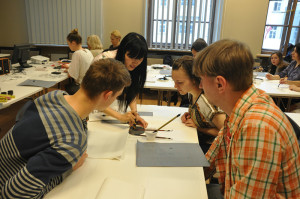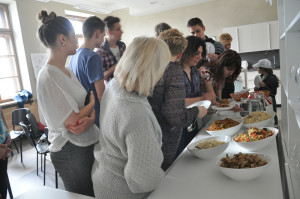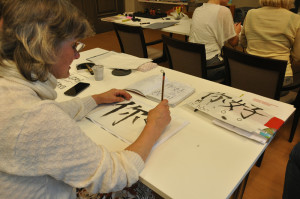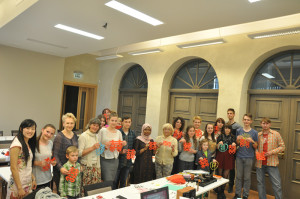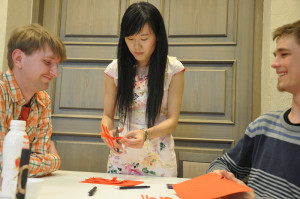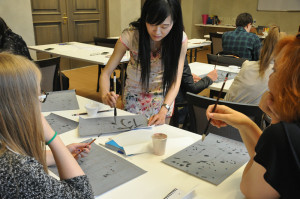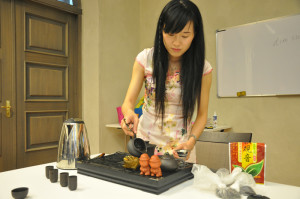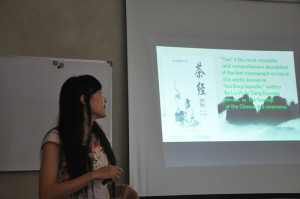Confucius Classroom at Rezekne University held “Chinese Culture Day” activities
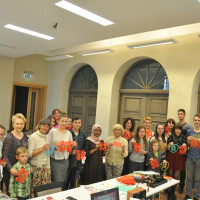
Latvia Local time at 15:30 on May 11 2016, the first “Chinese Culture Day” activities in Confucius Classroom at Rezekne University began,which attracted a large number of teachers , students and the local people to participate.
The “Chinese Culture Day” is divided into four themes, the first part is “China – the homeland of tea”, the second part is “the origin of Chinese Character and Calligraphy”, followed by ” the beauty of paper cutting,” and “Chinese tasty cuisine”.
First, the audience learned a lot of knowledge about tea from a lively tea culture lecture, such as the history and development of tea, China is the homeland of tea , there are six major categories of tea in China and China’s top ten tea , and various tea culture customs among China and all over the world. After the lecture, Chinese teacher Liang Mingxuan showed the audience how to make Tieguanyin and Lushan Yunwu this two kinds of tea, and invited them to taste the tea.
Before the second part started,the Chinese teacher asked the audience their views of Chinese characters, some people said that Chinese characters are quite different from the phonography used in most Western countries, which looks like a bit difficult, just as an art. The Chinese teacher told them that if they listen to the following lecture carefully, they would have a different view about Chinese characters.She explained that the origin and meaning of Chinese characters,which are ideographic characters only existed now, and then the development and change of Chinese characters, so that the audience had a better understanding about Chinese characters.Then she explained the Seal, the the Official, the Regular, the Cursive, the Running hand this five scripts,which can not only show the shapes of Chinese characters but also the beauty of calligraphy. In the introduction to “four treasures of the study”, she began to demonstrate to the audience how to write calligraphy , ” hello ” in the Regular and ” China “in the Seal, and taught them to practice patiently. After practicing calligraphy, the audience followed the Chinese teacher to speak: “Hello, China.”in Chinese loudly.
Next is the third lecture about paper cutting culture. The Chinese teacher talked about the culture of paper cutting from the meaning,the basic purpose, features and the use of paper cutting art in modern life . Everyone felt amazed when the Chinese teacher showed them the single color and mixed color of paper cutting . After the the lecture of paper cutting , the next is to experience the paper cutting, the Chinese teacher showed a variety of paper cutting of “double happiness”, after that ,she began to teach everyone to draw and cut “Double Happiness “,when the audience completed their paper cutting, they were very satisfied with their work.
The final part is the Chinese cuisine tasting, the Chinese teachers first introduced the audience the Chinese food that prepared by the Chinese restaurant,and told them Chinese people’s favorite food ,the differences between Eastern and Western eating customs, such as Chinese people like hot food while Westerners prefer cold cuts, before tasting food, she taught the audience how to use chopsticks patiently, later the teachers and students can use chopsticks to tasete the delicious Chinese cuisine.
After more than a week of planning and preparation, the first “Chinese Culture Day” activities in Rezekne Confucius Classroom came to an end successfully. Thanks to Confucius Institute at University of Latvia ,Continuing Education Centre in Rezekne University and Antra,only with their support and assistance can this event be a success.The youngest participant is less than 6 years old, while the oldest participant is 73 years, this event really reflects that the local people in Rezekne appreciate Chinese culture, they expressed thanks and praise to the Chinese teachers after the event, and hoped there will be more Chinese cultural activities, which can help them have a better understanding about the deep foundation of Chinese culture.

